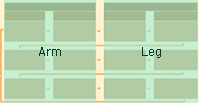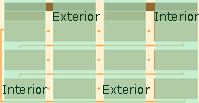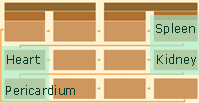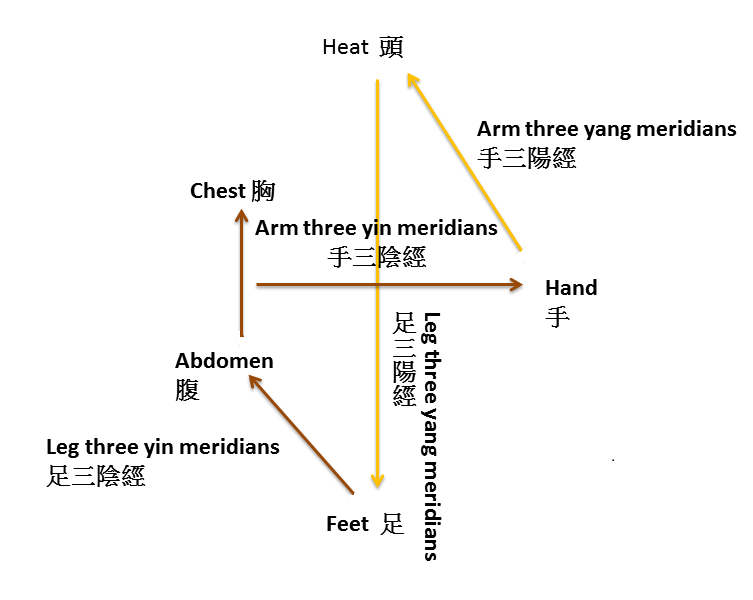Characteristics of Meridian Flow
Exterior towards Interior, Interior towards Exterior:
 For example, the Lung Meridian (Tai Yin) flows towards the Large Intestine Meridian (Yang Ming). The lung and large intestine are yin and yang organ respectively and are paired in an interior-exterior relationship. Both of them belong to metal of the five elements too. TCM believes the interior belongs to yin and the exterior to yang, because this meridian flow can be considered as: "the internal metal yin running towards the external metal yang." In this way, the flow follows the yin yang theory and has shown its mobile development and harmonious balance.
For example, the Lung Meridian (Tai Yin) flows towards the Large Intestine Meridian (Yang Ming). The lung and large intestine are yin and yang organ respectively and are paired in an interior-exterior relationship. Both of them belong to metal of the five elements too. TCM believes the interior belongs to yin and the exterior to yang, because this meridian flow can be considered as: "the internal metal yin running towards the external metal yang." In this way, the flow follows the yin yang theory and has shown its mobile development and harmonious balance. Arm towards Leg, Leg towards Arm:
Another example is the Arm Large Intestine Meridian (Yang Ming) flowing towards the Leg Stomach Meridian (Yang Ming). This illustrates the arm and leg relationship.
Pattern of the Meridian Flow
 The meridian flow chart illustrates an interesting flow pattern which is organized to follow both vertical and horizontal orders. Horizontally, the six meridians on the left side of the chart are all on the arm, while those on the right side are all on the leg. Therefore, the meridian flow intrinsically has arm-to-leg and leg-to-arm patterns, which means there is a balance between the upper and lower parts of the body. All meridians communicate with the body in a balanced manner.
The meridian flow chart illustrates an interesting flow pattern which is organized to follow both vertical and horizontal orders. Horizontally, the six meridians on the left side of the chart are all on the arm, while those on the right side are all on the leg. Therefore, the meridian flow intrinsically has arm-to-leg and leg-to-arm patterns, which means there is a balance between the upper and lower parts of the body. All meridians communicate with the body in a balanced manner.  Among the six arm meridians, the three on the left-hand are interior meridians while those on the right are exterior meridians. Of the six leg meridians, the three on the left are exterior meridians, while the three on the right are interior. This beautiful symmetry shows meridians go from the interior of the arm towards the exterior of the arm. Then, they proceed from the exterior of the arm towards the exterior of the leg to the interior of the leg and so on.
Among the six arm meridians, the three on the left-hand are interior meridians while those on the right are exterior meridians. Of the six leg meridians, the three on the left are exterior meridians, while the three on the right are interior. This beautiful symmetry shows meridians go from the interior of the arm towards the exterior of the arm. Then, they proceed from the exterior of the arm towards the exterior of the leg to the interior of the leg and so on.  Meridians in the chart also have a vertical order. All yang meridians follow a downward order:
Meridians in the chart also have a vertical order. All yang meridians follow a downward order:- Yang Ming (meaning sunlight yang);
- Tai Yang (meaning greater yang);
- Shao Yan (meaning lesser yang).
For yin meridians, the order is :
- Tai Yin (meaning greater yin);
- Shao Yin (meaning absolute yin);
- Jue Yin (meaning lesser yin).
For example, Leg Tai Yin Spleen Meridian flows towards Arm Shao Yin Heart Meridian. The Leg Shao Yin Kidney Meridian flows towards the Arm Jue Yin Pericardium Meridian. Generally speaking, the meridian flow follows the order of Tai Yin, Shao Yin and Jue Yin. The yin yang theory governs the flow of meridians and their symmetrical and organized connections throughout the whole body.

Flowing directions of the yin and yang meridians on the limbs


